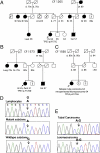Mutations in 12 genes for inherited ovarian, fallopian tube, and peritoneal carcinoma identified by massively parallel sequencing
- PMID: 22006311
- PMCID: PMC3207658
- DOI: 10.1073/pnas.1115052108
Mutations in 12 genes for inherited ovarian, fallopian tube, and peritoneal carcinoma identified by massively parallel sequencing
Abstract
Inherited loss-of-function mutations in BRCA1 and BRCA2 and other tumor suppressor genes predispose to ovarian carcinomas, but the overall burden of disease due to inherited mutations is not known. Using targeted capture and massively parallel genomic sequencing, we screened for germ-line mutations in 21 tumor suppressor genes in genomic DNA from women with primary ovarian, peritoneal, or fallopian tube carcinoma. Subjects were consecutively enrolled at diagnosis and not selected for age or family history. All classes of mutations, including point mutations and large genomic deletions and insertions, were detected. Of 360 subjects, 24% carried germ-line loss-of-function mutations: 18% in BRCA1 or BRCA2 and 6% in BARD1, BRIP1, CHEK2, MRE11A, MSH6, NBN, PALB2, RAD50, RAD51C, or TP53. Six of these genes were not previously implicated in inherited ovarian carcinoma. Primary carcinomas were generally characterized by genomic loss of normal alleles of the mutant genes. Of women with inherited mutations, >30% had no family history of breast or ovarian carcinoma, and >35% were 60 y or older at diagnosis. More patients with ovarian carcinoma carry cancer-predisposing mutations and in more genes than previously appreciated. Comprehensive genetic testing for inherited carcinoma is warranted for all women with ovarian, peritoneal, or fallopian tube carcinoma, regardless of age or family history. Clinical genetic testing is currently done gene by gene, with each test costing thousands of dollars. In contrast, massively parallel sequencing allows such testing for many genes simultaneously at low cost.
Conflict of interest statement
The authors declare no conflict of interest.
Figures



References
-
- King MC, Marks JH, Mandell JB. New York Breast Cancer Study Group Breast and ovarian cancer risks due to inherited mutations in BRCA1 and BRCA2. Science. 2003;302:643–646. - PubMed
-
- Zhang S, et al. Frequencies of BRCA1 and BRCA2 mutations among 1,342 unselected patients with invasive ovarian cancer. Gynecol Oncol. 2011;121:353–357. - PubMed
-
- Pal T, et al. BRCA1 and BRCA2 mutations account for a large proportion of ovarian carcinoma cases. Cancer. 2005;104:2807–2816. - PubMed
-
- Meindl A, et al. Germline mutations in breast and ovarian cancer pedigrees establish RAD51C as a human cancer susceptibility gene. Nat Genet. 2010;42:410–414. - PubMed
Publication types
MeSH terms
Grants and funding
LinkOut - more resources
Full Text Sources
Other Literature Sources
Medical
Research Materials
Miscellaneous

